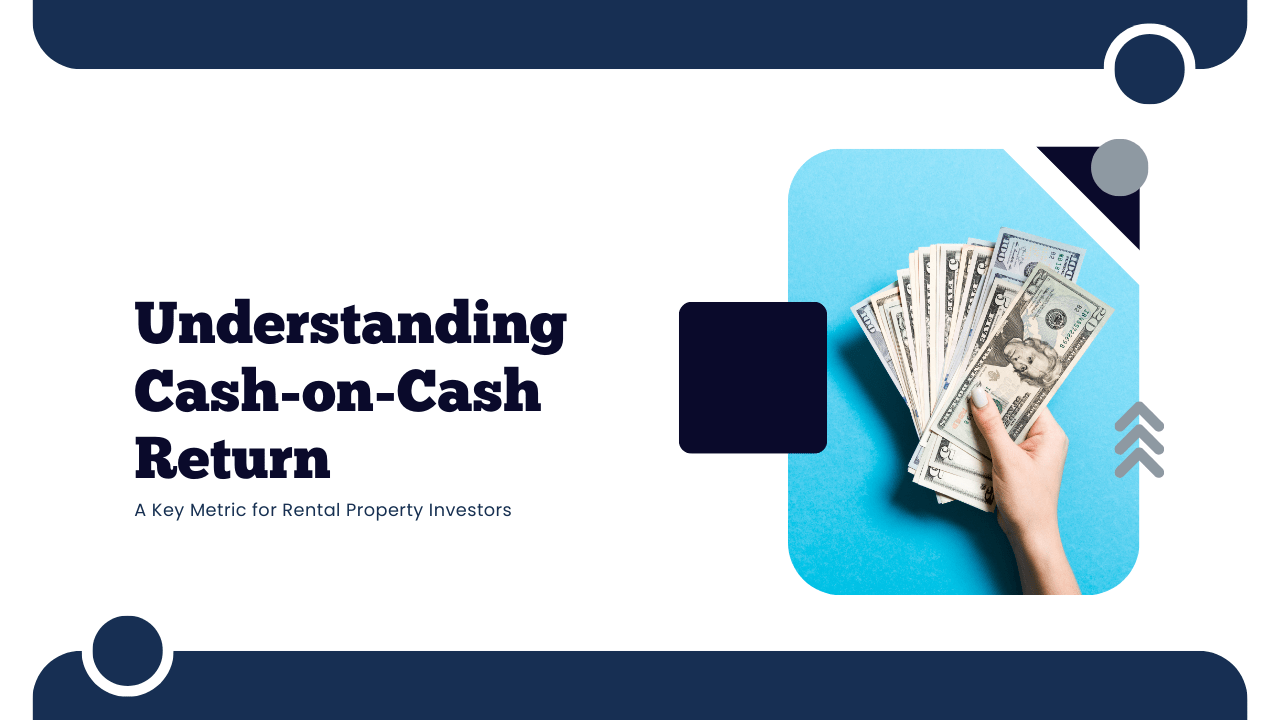How well is cash-on-cash return understood as a financial metric?
As most investors know, cash-on-cash return helps rental property owners to evaluate the profitability of their investment. It measures the annual pre-tax cash income earned on the actual money that has been invested in a property, typically expressed as a percentage.
This calculation helps investors understand how effectively their capital is working for them by comparing the income generated to the amount of money they’ve personally put into the deal, such as down payments and initial repairs. For rental property owners, a strong cash-on-cash return can indicate a healthy flow of income and a potentially worthwhile investment, especially when compared to other real estate or financial opportunities.
As California property managers, we use a number of metrics to identify rental properties that are performing well and those that need an adjustment. We are focused on cash-on-cash here in order to help investors gain a deeper understanding of what their properties are really earning for them.
If there’s any question around what we’re talking about, please get in touch with us at Bell Properties.
Cash-on-Cash Return: The Formula
 A cash-on-cash return (CCR) calculation determines the annual pre-tax cash flow generated by an investment property as a percentage of the total cash invested. It essentially measures how much cash a property owner is earning relative to how much they initially put in.
A cash-on-cash return (CCR) calculation determines the annual pre-tax cash flow generated by an investment property as a percentage of the total cash invested. It essentially measures how much cash a property owner is earning relative to how much they initially put in.
The formula is:
Cash-on-Cash Return (%) = (Annual Pre-Tax Cash Flow / Total Cash Invested) x 100
Here’s an example. Let’s say a buyer purchases an investment property for $600,000. Maybe the down payment made is $150,000, and another $30,000 is paid in closing costs and the repairs and renovations needed to get the property up and running and ready for the rental market. Annually, the property generates $15,000 in cash flow before taxes are paid. What’s the cash-on-cash return?
15,000/180,000 x 100: 8.3%
That means the owner is earning 8.3 percent on their investment every year before taxes. In California, that’s not a bad number at all. And that’s because California’s real estate market is unique. Prices are high, demand is intense, and regulations are often tighter than in other states. For owners, this means that:
Financing is critical. Few investors are buying all-cash in California, unless we’re talking about very specific markets that remain quite accessible.
Positive cash flow is harder to achieve. High property prices often come with razor-thin margins.
Strategic leverage matters. Cash-on-cash return helps determine if the leverage in your loan is actually working in your favor.
Pitfalls to Watch Out For
 While this is one of the most valuable metrics an investor can understand when it comes to California rental properties, it’s not always perfect. Here’s what California investors should keep in mind when measuring their own returns.
While this is one of the most valuable metrics an investor can understand when it comes to California rental properties, it’s not always perfect. Here’s what California investors should keep in mind when measuring their own returns.
It doesn’t factor appreciation. California is known for property value growth. Cash-on-cash return ignores that long-term upside. As we said early, a positive cash flow is often difficult to achieve in many California markets. That’s not a reason to avoid investing here, and it’s not a cause for concern reviewing financials. Real estate in California makes money, especially over the long term.
It assumes stable cash flow. Market conditions, rent control laws, or tenant issues can impact cash flow in ways this metric won’t predict. There are limits to what many owners can charge in rent in California. Evictions are nearly impossible to complete speedily or efficiently, so a lot of owners are left with months of no income. Cash flow won’t always be available to even plug into the equation that determines this type of return.
It doesn’t account for taxes. This is a pre-tax metric. An investor’s actual take-home return could be significantly different depending on their tax situation and income level outside of the rental property portfolio they own.
There are other key metrics that can be used in addition to cash-on-cash. To get a full picture of any rental property's performance, smart investors use a combination of metrics. Here are a few that complement cash-on-cash return:
Cap Rate (Capitalization Rate)
This measures the property’s annual net operating income (NOI) as a percentage of the purchase price or market value. It’s great for comparing potential investments side-by-side, especially if a property owner is managing to not leverage the property with financing.
Internal Rate of Return (IRR)
A more sophisticated metric, IRR estimates an investment’s total return over time, accounting for the time value of money. It’s especially helpful for multi-year investment projections or comparing projects with different timelines.
Gross Rent Multiplier (GRM)
This is a simple ratio of the property price divided by gross annual rental income. While less detailed, it’s a quick screening tool to identify overpriced or underpriced properties.
Debt Service Coverage Ratio (DSCR)
This tells owners whether the property generates enough income to cover its debt payments. Lenders use it heavily, and smart investors do, too, especially in higher-leverage markets throughout California.
Using a combination of these metrics will give investors a more holistic view of an investment’s potential and help them make better-informed decisions. We can help you run the numbers on any investment property, whether it’s time to buy, refinance, or optimize a rental strategy. Contact us at Bell Properties.
How to Improve Cash-on-Cash Return in California

Achieving a strong cash-on-cash return can be challenging due to high property prices and intense competition. However, with the right strategies, investors can significantly improve this key performance metric, and we can help. Here’s what we recommend.
Negotiate the Best Possible Financing Terms
Improving this particular metric starts before an investor even buys the property. Any financing structure can make or break the cash-on-cash return. Since California real estate is capital-intensive, securing favorable loan terms can free up the monthly cash flow and improve returns.
Always shop around for the best lending option. It’s easy to jump at the first loan offer, but well-qualified investors don’t have to settle for that. Compare rates from multiple lenders, including credit unions, community banks, and mortgage brokers who understand investment properties. Make sure they’re looking at a strong application; watch spending and debt, and keep a good credit score.
Leveraging relationships can also help. Long-standing banking relationships can yield better terms, such as lower interest rates, reduced fees, or flexible repayment structures.
A lot of investors will consider interest-only loans. This is especially valuable in high-growth areas where those interest-only loans can increase cash flow in the short term while the property appreciates. It’s also important to maximize loan-to-value strategically. A higher LTV allows buyers to invest less upfront, which can improve returns, though this must be balanced with risk.
It comes down to this: better financing terms mean lower monthly debt service and more money in your pocket.
Invest in Strategic Renovations and Improvements
California properties, especially older ones, often benefit significantly from targeted renovations. Improving a property not only enhances its value but can also result in earning higher rents.
Focus on ROI and the improvements that will deliver as much extra value as possible. Kitchen upgrades, modern bathrooms, and energy-efficient windows are popular with renters and often yield solid returns. It’s always a good idea to improve curb appeal. First impressions matter. Landscaping, fresh paint, and updated exteriors can make units more attractive and reduce vacancy rates.
Don’t forget the amenities. In-unit laundry, smart home features, or additional parking can justify rent increases, especially in competitive urban markets.
Renovations should be carefully budgeted and aligned with local market expectations. Investors who aren’t sure where to focus on improvements can benefit from an evaluation from our team. Contact us at Bell Properties.
Offer Value-Added Services to Boost Cash Flow
To enhance cash-on-cash return, consider additional services that generate passive income streams or allow for higher rents without significant capital investment. Something as simple as allowing pets can give income a boost. California has a high percentage of pet owners. Charging pet rent or pet fees can be a low-maintenance way to boost income.
Consider offering on-site services. Valet trash, vending, and parking can all generate ancillary revenue. A lot of owners are turning to furnished short-term rentals and flexible lease arrangements. This can yield a higher monthly income.
Improving the cash-on-cash return for a California investment property requires a proactive approach. By negotiating optimal financing, investing in smart renovations, and implementing value-added services, investors can navigate the state’s high entry costs and still enjoy strong returns. We don’t have to remind investors that staying agile and financially strategic is the key to long-term success in many of our markets throughout California.
 Cash-on-cash return is more than a number. This is a tool that can help investors make good decisions. In California, it’s especially important to assess risk and reward in a market that’s sometimes unpredictable. While it shouldn’t be the only metric in your toolkit, understanding and using it effectively can help you make smarter, more profitable investments.
Cash-on-cash return is more than a number. This is a tool that can help investors make good decisions. In California, it’s especially important to assess risk and reward in a market that’s sometimes unpredictable. While it shouldn’t be the only metric in your toolkit, understanding and using it effectively can help you make smarter, more profitable investments.
Let’s talk more about it. Contact us at Bell Properties.


